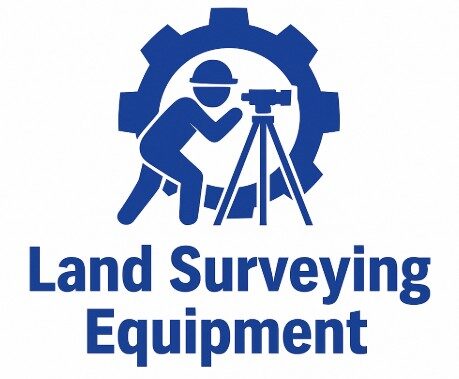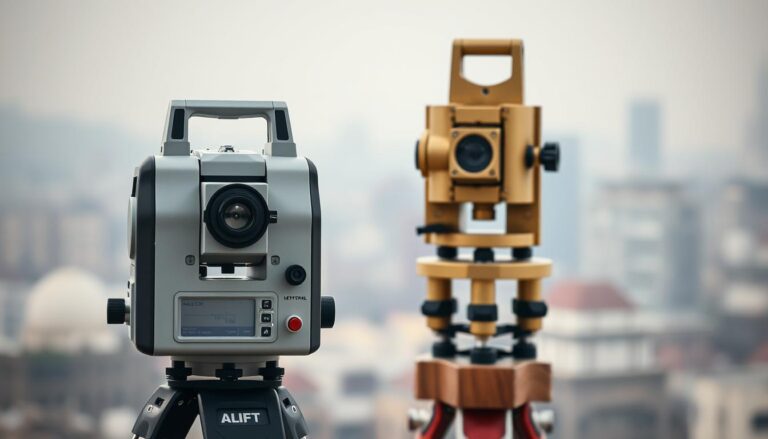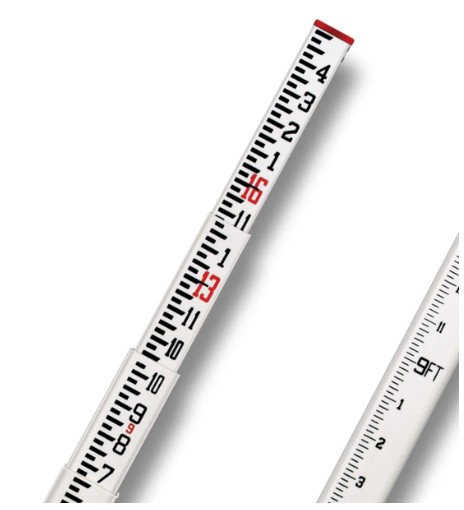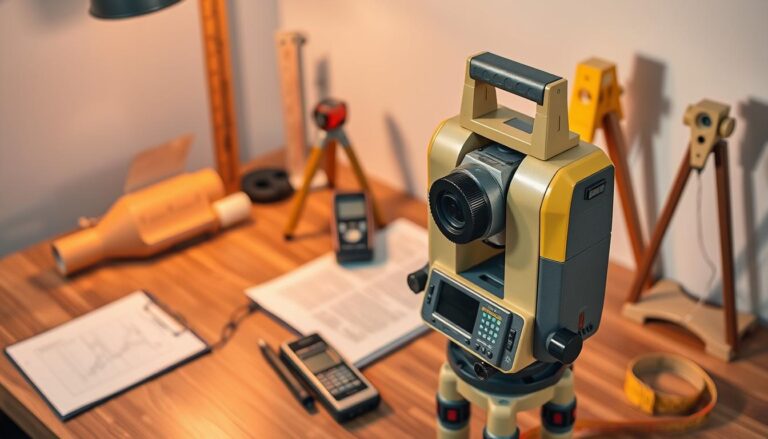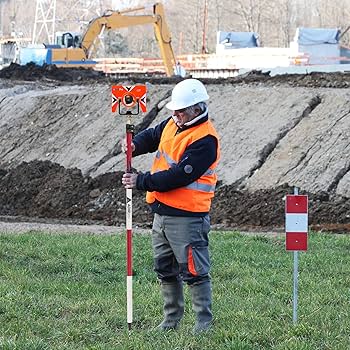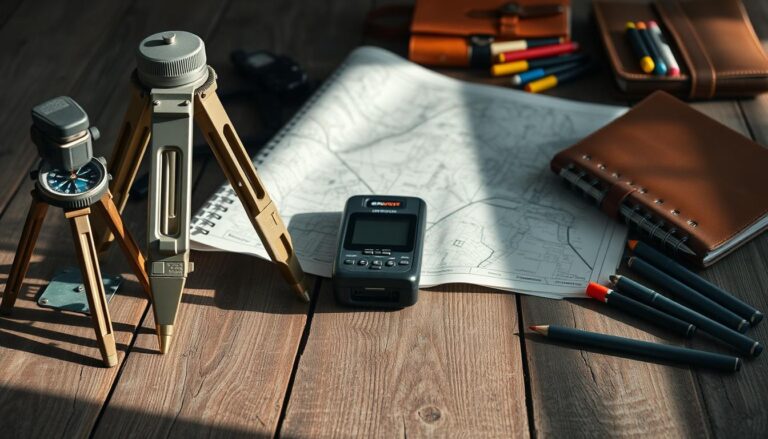Safety Vests for Land Surveyors: Vital Protection on the Job
Ensuring visibility is crucial for land surveyors who often work in hazardous environments or low-light conditions. High-visibility ANSI vests are a critical component of their safety gear.
These specialized garments are designed to maximize the wearer’s visibility. They make land surveyors more visible, which is key for safety on the job site. By wearing high-visibility vests, land surveyors can greatly lower the risk of accidents and injuries.
Key Takeaways
- High-visibility vests for Land Surveying are crucial for safety.
- ANSI vests improve visibility in hazardous work environments.
- Safety vests reduce the risk of accidents and injuries.
- Visibility is key to ensuring land surveyor safety.
- Specialized safety garments are essential for job site safety.
The Critical Role of Visibility in Surveying Work
Surveyors face many dangers, making it crucial to be seen. They work in places like construction sites and roads, where being visible is essential to stay safe.
Daily Hazards Land Surveyors Face
Land surveyors deal with many dangers every day. They might get hit by vehicles or heavy equipment. The Bureau of Labor Statistics reports thousands of workers get hurt or die each year in such incidents.
The risks are many:
- Being struck by moving vehicles or equipment
- Falling into trenches or other excavations
- Slipping on uneven or slippery surfaces
- Working near overhead hazards like power lines
How High-Visibility Gear Prevents Accidents
High-visibility gear, like high visibility vests for surveyors and surveyor reflective vests, is key to preventing accidents. These vests help make the wearer more visible, which is important in low light or against complex backgrounds.
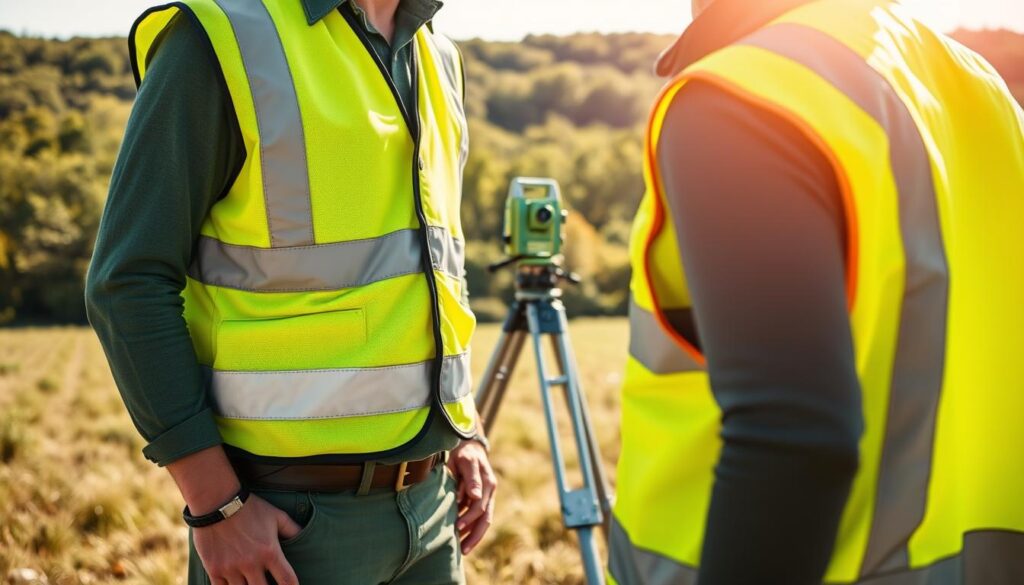
| Visibility Feature | Benefit | Standard Compliance |
|---|---|---|
| Bright Colors | Easy to spot in daylight | ANSI/ISEA 107 |
| Retroreflective Material | Visible at night or in low light | ANSI/ISEA 107 |
| Complex Pattern Design | Breaks up the outline, making it easier to see | Specific to manufacturer design |
By wearing high-visibility vests, surveyors greatly lower their accident risk. It’s a simple yet effective way to ensure a safe workday.
Safety Vests for Land Surveyors: Essential Features and Standards
The best safety vests for land surveyors are key. They must meet strict standards and have important features.
One major standard is the ANSI/ISEA 107 compliance. This rule sets out what safety vests should look like and be made of. It’s vital for making sure surveyors are seen and safe on the job.
ANSI/ISEA107 Compliance Requirements
ANSI/ISEA 107 compliance is a must for surveying safety vests. The standard groups vests by how well they show up and the danger of the job. Surveyors need to know these groups.
The standard also talks about the retroreflective materials in vests. These materials help show up at night or in dim light.
Class 2 vs. Class 3 Vests: Which Do Surveyors Need?
Surveyors often face complex and risky work. Choosing between Class 2 and Class 3 vests depends on the job’s danger. Class 2 is for slower traffic, while Class 3 is for faster or more dangerous areas.

Retroreflective Material Requirements
The retroreflective material in vests is crucial. It must reflect light back to its source. This makes surveyors more visible to drivers and others.
When picking a vest, look for ones with top-notch retroreflective materials. They should be tough and meet the ANSI/ISEA 107 standard.
Key Design Elements in Quality Surveyor Vests
The design of a surveyor vest is key to its success. It must be visible, comfortable, and functional. A good vest is more than just safe; it’s a tool for efficient work.
Equipment-Specific Storage Solutions
Quality surveyor vests have special storage for tools. They have pockets and compartments for surveying gear. This keeps everything within reach.
Pockets for GPS Units and Data Collectors
Many vests have special pockets for GPS and data collectors. These pockets make it easy to access these tools. This helps surveyors work better.
Loops and Holders for Measuring Tools
Surveyor vests also have loops and holders for tools like tape measures and stakes. These features keep the workspace tidy. They ensure tools are always ready when needed.
| Storage Feature | Description | Benefit |
|---|---|---|
| Pockets for GPS Units | Dedicated pockets for GPS devices | Easy access to GPS units |
| Data Collector Pockets | Pockets designed for data collection devices | Convenient storage for data collectors |
| Tool Loops and Holders | Loops and holders for various measuring tools | Organized workspace and easy tool access |
Weather Resistance and Durability Factors
Surveyor vests must handle different weather and rough use. They are made from weather-resistant materials. This makes them durable and effective over time.
“A good surveyor vest should be able to withstand the elements and the rigors of the job. It’s not just about being visible; it’s about being prepared.”
Comfort Features for All-Day Wear
Comfort is crucial in surveyor vest design. Features like breathable mesh, adjustable straps, and light materials ensure comfort all day.
Quality surveyor vests offer safety, function, and comfort. They help surveyors do their jobs well.
Top 7 Safety Vests for Land Surveyors in 2023
2023 brings new safety vests for land surveyors. They meet different needs and tastes.
Land surveyors have many safety vest choices. Here are the top 7 for 2023, each with special features and benefits.
1. ML Kishigo 1513 Premium Black Series Surveyor Vest
The ML Kishigo 1513 is for tough surveying jobs.
Key Features and Specifications
- ANSI/ISEA 107-2015 Class 2 compliant
- Premium black mesh fabric for breathability
- Multiple pockets for storage
- Adjustable sides for a comfortable fit
Pros and Cons
Pros: Durable, comfy, and very visible.
Cons: Some find it pricey.
Best For: Heavy-Duty Surveying Projects
Great for complex, risky projects needing more visibility and durability.
2. Ergodyne GloWear 8254HDZ Class 2 Surveyor Vest
The Ergodyne GloWear 8254HDZ fits many surveying settings.
Key Features and Specifications
- ANSI/ISEA 107-2015 Class 2 compliant
- Moisture-wicking fabric for comfort
- Multiple reflective strips for enhanced visibility
- Zippered pockets for secure storage
Pros and Cons
Pros: Great visibility, comfy, and durable.
Cons: Not for extreme cold.
Best For: All-Weather Conditions
Good for surveyors in various weather, except extreme cold.
3. DEWALT DSV521 Class 2 Surveyor Vest
The DEWALT DSV521 is for urban surveying.
Key Features and Specifications
- ANSI/ISEA 107-2015 Class 2 compliant
- Mesh fabric for breathability
- Reflective strips for enhanced visibility
- Pockets for storage
Pros and Cons
Pros: Light, breathable, and visible.
Cons: Not as durable as others.
Best For: Urban Surveying Environments
Perfect for urban areas where seeing is key.
4. 3M Scotchlite 8712 Surveyor Safety Vest
The 3M Scotchlite 8712 is for top visibility.
Key Features and Specifications
- ANSI/ISEA 107-2015 Class 3 compliant
- Scotchlite reflective material for high visibility
- Breathable mesh fabric
- Multiple pockets for storage
Pros and Cons
Pros: Great visibility, durable, and comfy.
Cons: Can be bulkier.
Best For: Maximum Visibility Requirements
Best for those needing the highest visibility.
5. Radians SV59 Class 2 Heavy Duty Surveyor Safety Vest
The Radians SV59 is for rough terrain.
Key Features and Specifications
- ANSI/ISEA 107-2015 Class 2 compliant
- Heavy-duty fabric for durability
- Multiple reflective strips for enhanced visibility
- Pockets for storage
Pros and Cons
Pros: Durable, comfy, and visible.
Cons: Heavier than others.
Best For: Rugged Terrain Surveying
Great for surveyors in tough environments.
6. Viking 4915SG Professional Surveyor Vest
The Viking 4915SG is versatile for many projects.
Key Features and Specifications
- ANSI/ISEA 107-2015 Class 2 compliant
- Mesh fabric for breathability
- Reflective strips for enhanced visibility
- Multiple pockets for storage
Pros and Cons
Pros: Versatile, comfy, and visible.
Cons: Not as durable as some.
Best For: Versatility Across Projects
Perfect for surveyors on various projects needing a versatile vest.
7. Pyramex RVZ2410 Class 2 Surveyor Safety Vest
The Pyramex RVZ2410 is budget-friendly.
Key Features and Specifications
- ANSI/ISEA 107-2015 Class 2 compliant
- Mesh fabric for breathability
- Reflective strips for enhanced visibility
- Pockets for storage
Pros and Cons
Pros: Affordable, light, and visible.
Cons: Not as durable as premium ones.
Best For: Budget-Conscious Professionals
Specialized Vests for Different Surveying Environments
Different surveying environments need special high-visibility vests. Surveyors work in many places, like highways, construction sites, and rural areas. Each place has its own safety challenges.
Highway and Roadside Surveying Safety Vests
For highway and roadside surveying, vests must be very visible. They are usually ANSI/ISEA 107 Class 2 or Class 3 compliant. This ensures they meet high visibility standards.
Key features of these vests include:
- High-visibility colors and reflective striping
- Durable, weather-resistant materials
- Compliance with ANSI/ISEA standards
Construction Site-Specific Surveyor Vests
Construction sites are dangerous, with heavy machinery and falling objects. Surveyor safety vests for these areas often have extra features like:
- Enhanced durability to withstand harsh conditions
- Pockets and storage for equipment
- Compatibility with other personal protective equipment (PPE)
Rural and Wilderness Surveying Visibility Solutions
In rural and wilderness areas, surveyors face challenges like limited visibility. Vests for these places might have:
- Camouflage or muted colors to avoid startling wildlife
- High-visibility elements for work near roads or other hazards
- Weather-resistant and breathable materials
Here’s a comparison of the different types of vests:
| Environment | Vest Features | ANSI/ISEA Class |
|---|---|---|
| Highway/Roadside | High-visibility, reflective striping, durable | Class 2 or 3 |
| Construction Site | Durable, equipment storage, PPE compatible | Class 2 or 3 |
| Rural/Wilderness | Breathable, weather-resistant, camouflage options | Class 2 |
Seasonal Considerations for Surveyor Safety Vests
Surveyors face many challenges all year round. The right safety vest is key to their safety and visibility. It must work well in different weather conditions.
Summer Heat-Management Vest Options
In summer, surveyors work in hot weather. Surveyor reflective vests for summer are made to keep cool and dry. They are light and have mesh to let air through while still being visible.
Some vests have special ventilation to keep workers comfortable. For example, mesh panels help manage heat.
Winter and Cold Weather Safety Vests
In winter, surveyors need vests that keep them warm and visible. They wear outerwear coats or jackets over their vests for extra warmth. These are made to be waterproof and have pockets for tools.
Winter vests should be waterproof and breathable. They also need insulation and bright colors or reflective strips for visibility in the dark.
| Season | Key Features | Benefits |
|---|---|---|
| Summer | Breathable, moisture-wicking materials; mesh panels for ventilation | Enhanced comfort; reduced heat stress |
| Winter | Waterproof and breathable membranes; insulation; high-visibility materials | Protection against cold and wet conditions; maintained visibility |
| Rainy/Adverse Weather | Waterproof materials; reflective strips; adjustable fittings | Safety in low visibility conditions; comfort and dryness |
Rain and Adverse Weather Protection
For rainy or bad weather, surveyors need vests that are waterproof and visible. Surveyor reflective vests for these conditions are made to keep dry and breathable. They prevent moisture buildup.
These vests also have adjustable parts to stay in place in windy or rainy weather. They use bright colors and reflective materials to keep surveyors seen, even in bad weather.
Integrating Safety Vests with Other Surveying Equipment
Surveying work needs safety vests to work well with other gear. Surveyors often face complex settings. Their safety vests must fit with other equipment for best protection and work.
It’s important to mix safety vests with surveying tools. This makes surveyors work better and safer. For example, a vest that fits with harnesses and tool belts lets surveyors move easily and safely.
Compatibility with Harnesses and Tool Belts
When safety vests match with harnesses and tool belts, it helps a lot. Some vests have multiple pockets and storage options. This lets surveyors carry tools and equipment easily.
An expert on survey equipment says, “The right safety vest changes everything on a job site. It’s not just about being seen; it’s about being useful and comfy too.”
“A well-designed safety vest should fit perfectly with other safety gear, like harnesses, for full protection.”
Accommodating Electronic Devices and Batteries
Today’s surveying uses electronic tools, and safety vests can hold these and their batteries. They have specialized pockets or compartments for safe and easy access.
For field surveyors, a vest that holds their devices means they can stay connected and work well. It’s about making a seamless workflow that values both safety and efficiency.
By linking safety vests with surveying tools, surveyors get a better and safer job. This mix is crucial for better job safety and efficiency. It’s a key part of any surveying job.
Proper Maintenance to Extend Your Safety Vest’s Lifespan
To keep your ansi certified surveyor vests in top shape, regular maintenance is crucial.
A well-kept safety vest lasts longer. It also keeps land surveyors visible and safe.
Cleaning Methods That Preserve Reflective Properties
Cleaning your ansi certified surveyor vests often is vital for their reflective ability.
- Use mild detergents without harsh chemicals.
- Steer clear of fabric softeners and bleach, as they harm the reflective material.
- Wash the vest in cold water and air dry it.
- Don’t machine dry or iron the vest, as high heat ruins the reflective strips.
Storage and Inspection Routines
Right storage and regular checks are key to keeping your safety vest effective.
Storage Tips:
- Keep the vest in a cool, dry spot, away from sunlight.
- Don’t fold or crease the vest, as it damages the reflective material.
- Hang the vest or store it flat to keep its shape.
Inspection Routines:
- Check the vest regularly for wear and damage.
- Look for any damage or fading on the reflective strips.
- Make sure all seams and stitching are still good.
By sticking to these maintenance tips, you can make your ansi certified surveyor vests last longer. They’ll keep providing the needed protection and visibility on the job.
Cost Analysis: Budget vs. Premium Surveyor Vests
Surveyor equipment vests come in different prices. This makes us wonder if cheaper options are good enough or if we should spend more on premium vests.
The market has many safety vests, from basic to high-end. Each has its own features and meets safety standards. Knowing the differences helps us make a smart choice.
Entry-Level Options That Meet Safety Standards
Basic surveyor vests are affordable and still safe. They have the minimum safety features, like ANSI/ISEA 107 compliance. This ensures they are visible and protect surveyors.
Key features of entry-level vests include:
- Basic retroreflective material for visibility
- Simple design with fewer pockets and storage options
- Compliance with safety standards for Class 2 or Class 3
Brands like Radians and Pyramex have affordable options. For example, the Pyramex RVZ2410 Class 2 Surveyor Safety Vest is a budget-friendly choice with essential safety features.
Long-Term Value of Higher-End Safety Vests
Premium surveyor vests cost more but offer more. They have better retroreflective materials, more storage, and last longer.
Benefits of premium vests include:
- Enhanced visibility with advanced retroreflective technology
- Increased durability and weather resistance
- More storage options for equipment and personal items
As
“The best safety vest can be a critical factor in preventing accidents on the job site.”
, spending on a premium vest like theML Kishigo 1513 Premium Black Series Surveyor Vestcan save money in the long run. It means fewer replacements and lower costs over time.
In conclusion, while cheaper vests are available and safe, premium vests offer more. They have better features and last longer. This makes them a good investment for many professionals.
Conclusion: Investing in Your Safety on the Surveying Job
Choosing the right safety vest is key for surveyors to stay safe and seen on the job. High visibility vests are more than just a rule; they’re a must-have for surveyors. They help lower the risk of accidents in many work settings.
Land surveyor safety vests come with important features like ANSI/ISEA 107 compliance and durable materials. They are crucial for surveyors working on highways, construction sites, or in rural areas. The right vest can mean the difference between safety and danger.
When surveyors pick the right high visibility vest, they boost their visibility and safety. They also stay productive. It’s important to think about the work environment, weather, and extra features needed.
In the end, investing in safety vests is a smart move for surveyors. It keeps them safe and secure in their jobs.
